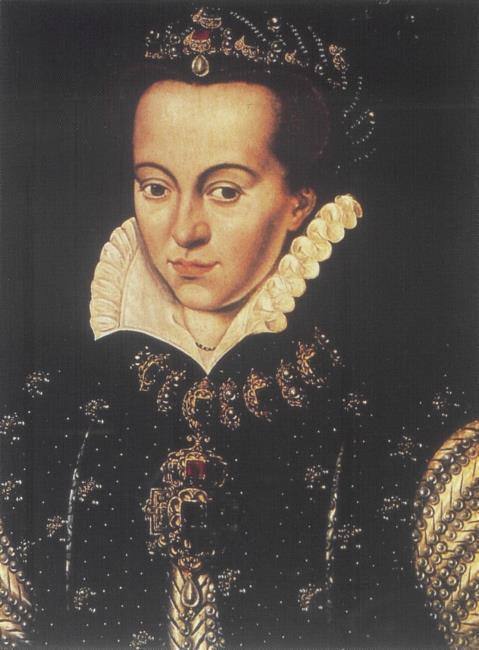by Susan Flantzer
© Unofficial Royalty 2018

Anna of Saxony, Princess of Orange; Credit – Wikipedia
Three years after the death of his first wife, Willem I (the Silent), Prince of Orange married again. On August 25, 1561, he married Anna of Saxony. However, the marriage would not end happily, and neither would Anna’s life. Anna was born on December 23, 1544, in Dresden, Duchy of Saxony, now in Saxony, Germany. She was the only surviving child and heiress of Maurice, Elector of Saxony and his wife Agnes of Hesse, the eldest daughter of Philip I, Landgrave of Hesse.
Anna had one younger brother who lived for only six months:
- Albert of Saxony (1545 – 1546), died in infancy
In 1553, Anna’s father died in battle during the Second Margrave War. In 1555, her mother remarried but died due to a miscarriage six months later. The eleven-year-old Anna was sent to live at the court of her uncle Augustus, Elector of Saxony in Dresden.
Since Anna was her father’s only heir, she was a wealthy young woman and attracted many royal suitors. The future King Eric XIV of Sweden made an unsuccessful marriage proposal, but it was Willem I, Prince of Orange who caught her attention. Anna’s dowry of 100,000 thalers was a very large amount of money. Willem was especially interested in the wealth and support he would acquire from Anna’s family in Saxony, Hesse-Kassel, and the Palatine. However, there was resistance to the marriage from Anna’s family. They thought she could get a husband with more status and they were concerned with the lack of Willem’s financial resources. Eventually, Willem’s persistent involvement in the marriage negotiations proved successful.
Willem and Anna had five children but only three survived to adulthood:
- Anna (born and died 1562)
- Anna (1563 – 1588), married her first cousin Count Willem Lodewijk of Nassau-Dillenburg, no children
- Maurits (1564 – 1566), died in early childhood
- Maurits, Prince of Orange (1567 – 1625), unmarried, no legitimate children
- Emilia (1569 – 1629), married Prince Manuel of Portugal, had eight children
Within a few months of the marriage, the couple began quarreling. By 1565, it was common knowledge at all the courts in Germany and in the Netherlands that the marriage was unhappy. After the death of her first son Maurits in 1566, Anna suffered severe depression. She tried to drown her grief with alcohol. The situation between Anna and Willem was strained and they often lived apart.
In early 1571, Anna realized she was pregnant. Immediately, the paternity was controversial. Two possibilities were discussed: either Anna’s husband Willem, who had visited Anna and his children during Christmas 1570, was the father or the lawyer Jan Rubens (the future father of the painter Peter Paul Rubens), who spent a lot of time with Anna as her legal adviser, was the father. A daughter, Christine, was born in August 1571.
Willem knew that his non-recognition of the child as his daughter would be a pretext for divorce by accusing Anna of adultery. Wilhelm accused Rubens of having had an adulterous relationship with his wife and of being the biological father of Christina. Rubens was imprisoned and threatened with execution. He confessed to adultery under torture and was pardoned on the intercession of his wife. Anna also admitted the adultery, but she denied that Rubens was the father. On December 14, 1571, Anna was forced to agree to a divorce. Christine, who had been given Dietz as a surname, was not recognized by Willem as his child and he did not have to pay any further maintenance for her.
In 1572, Anna was sent to her family in Saxony where they imprisoned her as an adulteress. The windows of her room were walled up and fitted with additional iron bars. A square hole was made in the door through which food and drink were given to her. An iron gate was installed outside the door prohibiting any attempt to escape. Anna died on December 18, 1577, at the Palace of the Elector of Saxony in Dresden, Electorate of Saxony, shortly before her 33rd birthday. She was buried in Meissen Cathedral in the Electorate of Saxony, now in Saxony, Germany, near her ancestors in a nameless tomb.
This article is the intellectual property of Unofficial Royalty and is NOT TO BE COPIED, EDITED, OR POSTED IN ANY FORM ON ANOTHER WEBSITE under any circumstances. It is permissible to use a link that directs to Unofficial Royalty.
